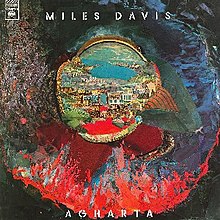
Back Agharta Czech Agharta (Album) German Agharta et Pangaea (Miles Davis) French Agharta (album) Italian アガルタ (アルバム) Japanese Agharta Korean Agharta Polish Agharta (álbum) Portuguese
| Agharta | ||||
|---|---|---|---|---|
 | ||||
| Live album by | ||||
| Released | August 1975 | |||
| Recorded | February 1, 1975 | |||
| Venue | Festival Hall (Osaka) | |||
| Genre | ||||
| Length | 97:34 | |||
| Label | CBS/Sony | |||
| Producer | Teo Macero | |||
| Miles Davis chronology | ||||
| ||||
| Miles Davis live chronology | ||||
| ||||
| Alternate cover | ||||
 1976 North American edition | ||||
Agharta is a 1975 live double album by American jazz trumpeter, composer, and bandleader Miles Davis. By the time he recorded the album, Davis was 48 years old and had alienated many in the jazz community while attracting younger rock audiences with his radical electric fusion music. After experimenting with different line-ups, he established a stable live band in 1973 and toured constantly for the next two years, despite physical pain from worsening health and emotional instability brought on by substance abuse. During a three-week tour of Japan in 1975, the trumpeter performed two concerts at the Festival Hall in Osaka on February 1; the afternoon show produced Agharta, and the evening show was released as Pangaea the following year.
Davis led a septet at the concert; saxophonist Sonny Fortune, bassist Michael Henderson, and guitarist Pete Cosey were given space to improvise against a dense backdrop of riffs, electronic effects, cross-beats, and funk grooves from the rhythm section – drummer Al Foster, guitarist Reggie Lucas, and percussionist James Mtume. Davis controlled their rhythmic and musical direction with hand and head gestures, phrases played on his wah-wah processed trumpet, and drones from an accompanying electronic organ. The evolving nature of the performance led to the widespread misunderstanding that it had no compositional basis, while its dark, angry, and somber musical qualities were seen as a reflection of the bandleader's emotional and spiritual state at the time.
Agharta was first released in Japan by CBS/Sony in August 1975 just before Davis temporarily retired due to increasingly poor health and exhaustion. At the record label's suggestion, it was titled after the legendary subterranean city. Davis enlisted Japanese artist Tadanori Yokoo to design its artwork, which depicted the cityscape of an advanced civilization with elements inspired by Eastern subterranean myths, Afrofuturism, and ufology. An alternate cover was produced for its 1976 release in North America by Columbia Records.
A highly divisive record, Agharta further challenged Davis' jazz audience and was widely panned by contemporary critics; reviewers found the music discordant and complained of Cosey's loud guitar sounds and Davis' sparse trumpet playing. It was reevaluated positively in subsequent years, however, as a generation of younger musicians was influenced by the band's abrasive music and cathartic playing, particularly Cosey's effects-laden free improvisations. Agharta has since been viewed as an important jazz-rock record, a dramatically dynamic group performance, and the culmination of Davis' electric period spanning the late 1960s and mid-1970s.
© MMXXIII Rich X Search. We shall prevail. All rights reserved. Rich X Search